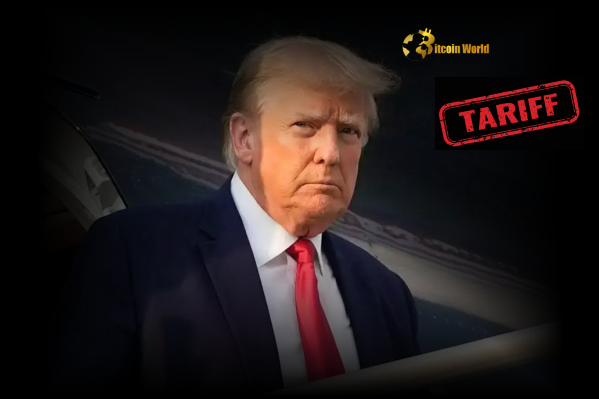BitcoinWorld

Ethereum Whale Withdrawal: Unpacking the $10 Million Kraken Move
In the dynamic world of cryptocurrency, few events capture attention quite like a significant Ethereum whale withdrawal. Recently, the crypto community buzzed with news of a massive 2,850 ETH, valued at an astonishing $10.09 million, being moved from the Kraken exchange. This isn’t just a large transaction; it’s a potential signal from one of the market’s most influential players, and understanding its implications is crucial for anyone navigating the digital asset landscape. Let’s dive into what this major move signifies for the Ethereum ecosystem and the broader crypto market.
What Does a Large Ethereum Whale Withdrawal Mean?
When an anonymous entity, often referred to as a “whale” due to their immense holdings, moves a substantial amount of cryptocurrency off an exchange, it typically signals a shift in strategy. In this particular instance, an address identified as 0x1c11 executed a significant Ethereum whale withdrawal from Kraken. Data from Onchain Lens on X confirmed this transaction, highlighting the transfer of 2,850 ETH, equivalent to over $10 million at the time of withdrawal. This address now holds a staggering 18,111 ETH, valued at approximately $64 million, suggesting a long-term conviction in Ethereum’s value rather than short-term trading.
Such withdrawals are generally interpreted as a move towards holding, or “hodling,” as it removes assets from immediate trading liquidity. This contrasts sharply with deposits to exchanges, which often precede selling pressure. The sheer scale of this particular Ethereum whale withdrawal commands attention because whale movements can sometimes precede broader market trends, acting as an indicator for smaller investors. It suggests that a powerful market participant sees more value in holding their ETH off-exchange than in keeping it readily available for sale.
Why Do Whales Withdraw ETH from Exchanges?
The motivations behind a significant Ethereum whale withdrawal are multifaceted, but they generally revolve around a few key strategic decisions:
- Enhanced Security: Moving funds from an exchange to a private, self-custodied wallet (often a hardware wallet) significantly reduces counterparty risk. While exchanges offer convenience, they are susceptible to hacks, regulatory issues, or operational failures. A whale, with millions at stake, prioritizes the security of their assets above all else.
- Long-Term Holding (Hodling): A withdrawal indicates an intent to hold assets for an extended period, rather than actively trade them. This suggests the whale believes Ethereum’s value will appreciate over time, making short-term price fluctuations less relevant to their strategy. It’s a vote of confidence in the asset’s future potential.
- Staking or DeFi Participation: Once off an exchange, ETH can be used for various decentralized finance (DeFi) activities or staked to earn yield. With Ethereum’s transition to Proof-of-Stake (PoS), staking ETH is a popular way to earn passive income, and it requires holding ETH in a non-custodial wallet to participate directly.
- Reduced Trading Temptation: By removing funds from an active trading platform, whales can avoid impulsive trading decisions driven by market volatility. This disciplined approach aligns with a long-term investment philosophy, protecting their substantial capital from short-term market noise.
To illustrate the difference in asset management strategies, consider the following comparison:
| Aspect | Holding on Exchange | Self-Custody (Post-Withdrawal) |
|---|---|---|
| Security Risk | Higher (Exchange hacks, regulatory risks) | Lower (User controls private keys) |
| Purpose | Active Trading, Quick Access | Long-Term Holding, Staking, DeFi |
| Control | Exchange controls keys | User controls keys |
| Liquidity | High (Ready to sell) | Lower (Needs to be redeposited to sell) |
How Do Whales Influence the Ethereum Market?
The actions of whales, especially a significant Ethereum whale withdrawal, can send ripples through the market. While no single whale can unilaterally control the entire market, their movements are closely watched for several reasons:
- Sentiment Indicator: A large withdrawal is often seen as a bullish signal. It suggests that a major holder is not planning to sell in the near future, reducing potential selling pressure. Conversely, large deposits to exchanges can indicate an impending sell-off, which traders often interpret as a bearish sign.
- Supply Dynamics: When ETH is moved off exchanges, the circulating supply available for immediate trading decreases. In theory, if demand remains constant or increases, a reduced supply on exchanges could lead to upward price pressure. This basic economic principle of supply and demand plays out vividly in the crypto markets.
- Follow-the-Leader Effect: Smaller investors and algorithmic traders often monitor whale movements. If a prominent whale makes a move, others might follow suit, amplifying the initial signal. This herd mentality can sometimes accelerate market trends, whether positive or negative.
However, it is crucial to remember that whale movements are not infallible predictors. The identity and exact intentions of the anonymous whale remain unknown. They could be moving funds for private sales, institutional transfers, or other reasons not immediately apparent to the public. Therefore, while this Ethereum whale withdrawal is noteworthy, it should be considered as one data point among many when assessing overall market conditions and future price action.
What are the Challenges and Risks of Tracking Whale Movements?
While on-chain data provides unprecedented transparency into cryptocurrency movements, interpreting whale activity, such as a large Ethereum whale withdrawal, comes with its own set of challenges and risks:
- Anonymity: Blockchain addresses are pseudonymous. We can see the transactions, but we don’t know who owns the address (an individual, an institution, a fund, or even multiple entities). This anonymity makes it difficult to ascertain the exact motivations behind their actions, adding a layer of uncertainty.
- Misinterpretation: A withdrawal might not always mean “hodling.” It could be a transfer to another wallet for security reasons, an OTC (over-the-counter) sale that doesn’t involve an exchange, or preparation for a large institutional transaction. Without complete context, interpretations can be speculative and potentially misleading.
- Market Manipulation: Sophisticated whales might intentionally make movements to influence market sentiment, creating FUD (Fear, Uncertainty, Doubt) or FOMO (Fear of Missing Out) to benefit their own trading strategies. While less common with withdrawals for holding, the possibility of deceptive moves exists.
- Data Overload: The sheer volume of on-chain data can be overwhelming for the average user. Identifying truly significant whale movements requires specialized tools and expertise, like those provided by Onchain Lens, to filter out noise and identify meaningful patterns that are genuinely indicative of market shifts.
Therefore, while observing a significant Ethereum whale withdrawal offers valuable insights, it is vital for investors to combine this information with broader market analysis, fundamental project developments, and macroeconomic factors before making investment decisions. Relying solely on whale movements can lead to incomplete or inaccurate conclusions.
Actionable Insights for Investors from This Ethereum Whale Withdrawal
For the average investor, the news of a substantial Ethereum whale withdrawal can be more than just an interesting headline; it can offer valuable perspectives for refining one’s own investment strategy. Here are some actionable insights you might consider:
- Consider Your Time Horizon: If large players are moving assets for long-term holding, it encourages retail investors to re-evaluate their own time horizons. Short-term trading is high-risk and often leads to losses, while a long-term view, similar to that implied by whale withdrawals, can often yield better and more stable results.
- Prioritize Security: The whale’s move to self-custody highlights the importance of securing your assets. For smaller amounts, a reputable exchange might suffice, but as your holdings grow, exploring hardware wallets and other self-custody solutions becomes increasingly important to protect your investments from external risks.
- Diversify Information Sources: Do not rely solely on whale movements. Combine on-chain data with fundamental analysis of Ethereum’s ecosystem, technological advancements (like scaling solutions and upgrades), adoption rates, and overall macroeconomic trends. A holistic view provides a more robust understanding.
- Avoid Emotional Decisions: While a whale withdrawal can spark optimism, resist the urge to make impulsive buys. Instead, use such data points to inform a well-thought-out investment plan based on your own risk tolerance, financial goals, and thorough research, rather than reacting to every market signal.
- Stay Informed: Follow reputable on-chain analytics providers and crypto news sources to stay updated on significant market movements. Understanding these trends, including large transfers like this Ethereum whale withdrawal, can provide an edge in anticipating potential shifts and making more informed decisions.
This particular Ethereum whale withdrawal from Kraken serves as a powerful reminder that significant capital is being positioned for what appears to be a long-term play on Ethereum’s future. It underscores the ongoing maturation of the crypto market, where sophisticated investors are making calculated moves beyond daily price swings, focusing on the underlying value and long-term potential of digital assets.
The recent Ethereum whale withdrawal of $10.09 million from Kraken by address 0x1c11 is a notable event in the crypto space. This substantial movement of 2,850 ETH off an exchange suggests a strong intent to hold assets for the long term, rather than for immediate trading. While whale actions can influence market sentiment and supply dynamics, it is crucial for investors to interpret such data cautiously, combining it with comprehensive research and a disciplined approach. This event reinforces the growing trend among large holders to prioritize security and long-term conviction in their digital asset strategies, highlighting the importance of understanding on-chain analytics in today’s crypto landscape.
Frequently Asked Questions (FAQs)
1. What is an Ethereum whale?
An Ethereum whale is an individual or entity that holds a very large amount of Ethereum (ETH), typically enough to significantly influence market sentiment or price movements with their transactions. These holdings often range from tens of thousands to hundreds of thousands of ETH.
2. Why are whale withdrawals from exchanges considered significant?
Whale withdrawals are significant because they often indicate an intent to hold assets for the long term (hodling) rather than selling them immediately. Moving funds off an exchange reduces the immediate selling pressure on the market and can be interpreted as a bullish signal, suggesting the whale has strong conviction in the asset’s future value.
3. How does an Ethereum whale withdrawal affect ETH price?
While not a direct cause-and-effect, a large Ethereum whale withdrawal can positively influence market sentiment by reducing the supply of ETH available on exchanges for immediate sale. This perceived scarcity, combined with the “follow-the-leader” effect, can sometimes contribute to upward price pressure, though it’s one of many factors influencing price.
4. Is it safer to keep ETH in a self-custodied wallet than on an exchange?
Generally, yes, for large amounts. Self-custody, especially with hardware wallets, provides greater security as you control your private keys, eliminating counterparty risk from exchange hacks or failures. However, it also places full responsibility for security on the user, requiring careful management of private keys and recovery phrases.
5. What is Onchain Lens, and how does it track whale movements?
Onchain Lens is a blockchain analytics tool or platform (as referenced in the article) that monitors and interprets real-time data from public blockchains. It identifies large transactions, tracks specific addresses, and provides insights into market movements, including significant whale activities like the Ethereum whale withdrawal discussed.
6. Can I track Ethereum whale movements myself?
Yes, to some extent. You can use public blockchain explorers (like Etherscan) to view transactions. However, interpreting these movements, identifying whale addresses, and understanding their broader implications often requires specialized on-chain analytics platforms and expertise, as raw data can be complex and overwhelming for casual observers.
Did you find this analysis of the Ethereum whale withdrawal insightful? Share this article with your friends and fellow crypto enthusiasts on social media to help them understand the nuances of significant on-chain movements and their potential market implications!
To learn more about the latest Ethereum market trends, explore our article on key developments shaping Ethereum’s institutional adoption.
This post Ethereum Whale Withdrawal: Unpacking the $10 Million Kraken Move first appeared on BitcoinWorld and is written by Editorial Team





